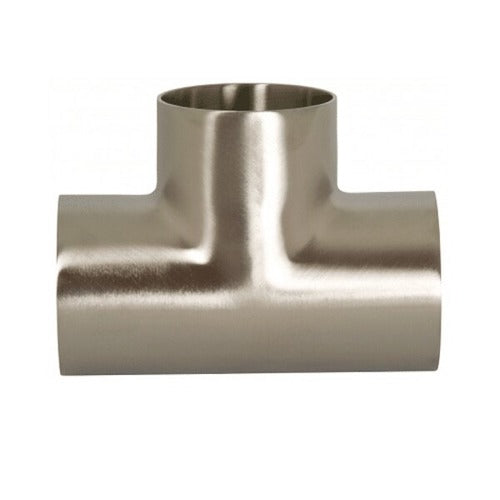304 Stainless Steel 1 1/2" Butt-Weld Short Tee
3-A Sanitary Certified
Material: 304 Stainless Steel
Size: 1 1/2 inch
Connection Type: Butt-Weld
Surface Finish: 32 Ra ID/OD
Weight: 0.23 lbsSKU: Item #: SS15BWST304
In Stock
Couldn't load pickup availability

Collapsible content
Description
Our 1 1/2 inch short butt weld tee is a durable and high quality fitting used to connect three pipes in a T-shaped configuration. Butt-weld tees are fittings that allow for changes in flow direction. They are perfect for branching, attaching auxiliary equipment, and more.
The short design provides a smaller and much more compact fitting without sacrificing any of the qualities like corrosion resistance or durability.
Made from 304 stainless steel, this short weld tee has excellent corrosion resistance and maintains impressive long-lasting performance while reducing risks of turbulence and pressure loss.
Butt-weld short tees are sometimes called weld short tees.
Uses:
Fluid distribution & mixing
Pressure control
Filtration processes
Steam transportation
Gas and Oil pipelines
Pharmaceutical
Dairy
Beverage
Fermentation
And all other space-constrained piping systems
Specs

| Stainless Steel Butt-Weld Short Tee, Polish ID/OD | ||||||
|---|---|---|---|---|---|---|
| Tube OD (Size) | Length (A) |
Ctr-to-Face (B) |
Nominal Wall | Weight (lbs) |
Part Number 304 SS | Part Number 316L SS |
| 1" | 1.125 | 2.250 | 0.065 | 0.120 | SS1BWST304 | SS1BWST316L |
| 1.5" | 1.656 | 3.312 | 0.065 | 0.230 | SS15BWST304 | SS15BWST316L |
| 2" | 2.062 | 4.124 | 0.065 | 0.580 | SS2BWST304 | SS2BWST316L |
| 2.5" | 2.344 | 4.688 | 0.065 | 0.750 | SS25BWST304 | SS25BWST316L |
| 3" | 2.594 | 5.188 | 0.065 | 1.360 | SS3BWST304 | SS3BWST316L |
| 4" | 3.438 | 6.876 | 0.083 | 2.290 | SS4BWST304 | SS4BWST316L |
*all measurements are in inches
304 vs. 316L Stainless Steel
304 and 316L stainless steels appear visually identical, but have distinct performance characteristics.
304 stainless steel contains approximately 18% chromium and 8% nickel, making it suitable for kitchen applications and indoor environments. It performs well under normal conditions but becomes vulnerable to corrosion when exposed to salt or harsh chemicals. This makes it the more economical option for standard uses where corrosion resistance is not a primary concern.
316L stainless steel contains 2-3% molybdenum in addition to chromium and nickel, providing superior corrosion resistance, especially against saltwater and chemicals. Furthermore, 316L has a lower carbon content than 316, increasing corrosion resistance and making it ideal for welding. While it commands a higher price point than 304, it is recommended for outdoor marine environments and food processing applications involving salt.
304 is useful for some standard applications, but for the highest level of durability and harsh environments or saltwater exposure, the additional investment in 316L stainless steel is justified for long-term success.
